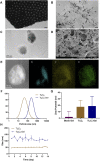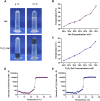Injectable and Temperature-Sensitive Titanium Carbide-Loaded Hydrogel System for Photothermal Therapy of Breast Cancer
- PMID: 35004650
- PMCID: PMC8733661
- DOI: 10.3389/fbioe.2021.791891
Injectable and Temperature-Sensitive Titanium Carbide-Loaded Hydrogel System for Photothermal Therapy of Breast Cancer
Abstract
Recently, organic-inorganic hybrid materials have gained much attention as effective photothermal agents for cancer treatment. In this study, Pluronic F127 hydrogel-coated titanium carbide (Ti3C2) nanoparticles were utilized as an injectable photothermal agent. The advantages of these nanoparticles are their green synthesis and excellent photothermal efficiency. In this system, lasers were mainly used to irradiate Ti3C2 nanoparticles to produce a constant high temperature, which damaged cancer cells. The nanoparticles were found to be stable during storage at low temperatures for at least 2 weeks. The Ti3C2 nanoparticles exhibited a shuttle-shaped structure, and the hydrogels presented a loosely meshed structure. In addition, Ti3C2 nanoparticles did not affect the reversible temperature sensitivity of the gel, and the hydrogel did not affect the photothermal properties of Ti3C2 nanoparticles. The in vitro and in vivo results show that this hydrogel system can effectively inhibit tumor growth upon exposure to near-infrared irradiation with excellent biocompatibility and biosafety. The photothermal agent-embedded hydrogel is a promising photothermal therapeutic strategy for cancer treatment by enhancing the retention in vivo and elevating the local temperature in tumors.
Keywords: Ti3C2 nanoparticles; anti-cancer; photothermal therapy; pluronic F127 hydrogel; thermosensitive.
Copyright © 2021 Yao, Zhu, Peng, Ma and Gao.
Conflict of interest statement
The authors declare that the research was conducted in the absence of any commercial or financial relationships that could be construed as a potential conflict of interest.
Figures






Similar articles
-
Titanium carbide MXene-based hybrid hydrogel for chemo-photothermal combinational treatment of localized bacterial infection.Acta Biomater. 2022 Apr 1;142:113-123. doi: 10.1016/j.actbio.2022.02.019. Epub 2022 Feb 19. Acta Biomater. 2022. PMID: 35189382
-
Development of dual-crosslinked Pluronic F127/Chitosan injectable hydrogels incorporating graphene nanosystems for breast cancer photothermal therapy and antibacterial applications.Eur J Pharm Biopharm. 2024 Oct;203:114476. doi: 10.1016/j.ejpb.2024.114476. Epub 2024 Aug 28. Eur J Pharm Biopharm. 2024. PMID: 39209129
-
CuS Nanodot-Loaded Thermosensitive Hydrogel for Anticancer Photothermal Therapy.Mol Pharm. 2018 Oct 1;15(10):4621-4631. doi: 10.1021/acs.molpharmaceut.8b00624. Epub 2018 Sep 13. Mol Pharm. 2018. PMID: 30179511
-
Injectable thermosensitive hydrogel-based drug delivery system for local cancer therapy.Colloids Surf B Biointerfaces. 2021 Apr;200:111581. doi: 10.1016/j.colsurfb.2021.111581. Epub 2021 Jan 16. Colloids Surf B Biointerfaces. 2021. PMID: 33524696 Review.
-
Photothermal nanohybrid hydrogels for biomedical applications.Front Bioeng Biotechnol. 2022 Nov 3;10:1066617. doi: 10.3389/fbioe.2022.1066617. eCollection 2022. Front Bioeng Biotechnol. 2022. PMID: 36406231 Free PMC article. Review.
Cited by
-
Polymer Gels: Classification and Recent Developments in Biomedical Applications.Gels. 2023 Feb 17;9(2):161. doi: 10.3390/gels9020161. Gels. 2023. PMID: 36826331 Free PMC article. Review.
-
Recent Advances in Hydrogel-Based Phototherapy for Tumor Treatment.Gels. 2023 Apr 1;9(4):286. doi: 10.3390/gels9040286. Gels. 2023. PMID: 37102898 Free PMC article. Review.
-
Bi2S3/Ti3C2-TPP nano-heterostructures induced by near-infrared for photodynamic therapy combined with photothermal therapy on hypoxic tumors.J Nanobiotechnology. 2024 Mar 20;22(1):123. doi: 10.1186/s12951-024-02391-x. J Nanobiotechnology. 2024. PMID: 38504272 Free PMC article.
-
Progress of Research in In Situ Smart Hydrogels for Local Antitumor Therapy: A Review.Pharmaceutics. 2022 Sep 23;14(10):2028. doi: 10.3390/pharmaceutics14102028. Pharmaceutics. 2022. PMID: 36297463 Free PMC article. Review.
-
Ultrasound-Triggered on Demand Lidocaine Release Relieves Postoperative Pain.Front Bioeng Biotechnol. 2022 Jul 11;10:925047. doi: 10.3389/fbioe.2022.925047. eCollection 2022. Front Bioeng Biotechnol. 2022. PMID: 35898649 Free PMC article.
References
LinkOut - more resources
Full Text Sources

